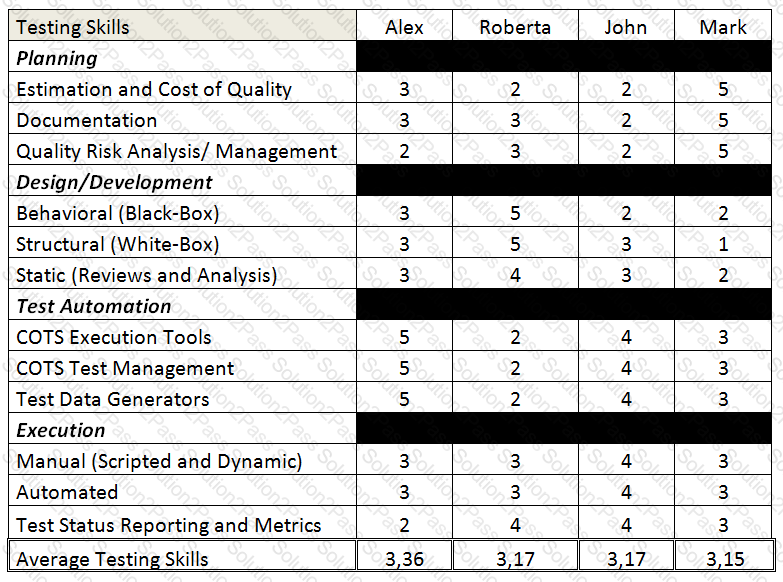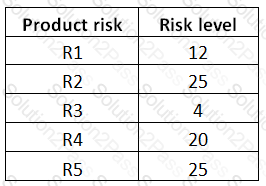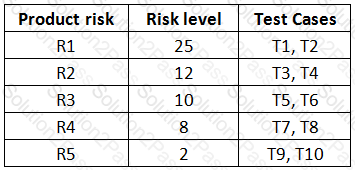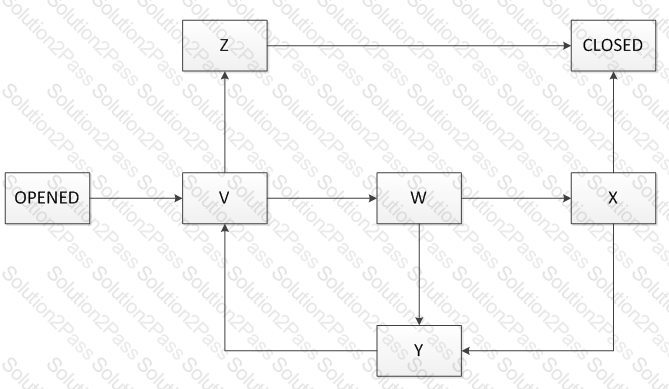TM12 BCS ISTQB-BCS Certified Tester Advanced Level- Test Manager (2012) Free Practice Exam Questions (2025 Updated)
Prepare effectively for your BCS TM12 ISTQB-BCS Certified Tester Advanced Level- Test Manager (2012) certification with our extensive collection of free, high-quality practice questions. Each question is designed to mirror the actual exam format and objectives, complete with comprehensive answers and detailed explanations. Our materials are regularly updated for 2025, ensuring you have the most current resources to build confidence and succeed on your first attempt.
Test Tools and Automation
Assume you are managing a test automation project for a mission-critical system.
Becausevendor provided tools and open source solutions don't meet the needs of this project, you ask your test team to develop a custom automation framework.
Which of the following management issues associated to the development of this custom automation framework is least likely to manage?
Number of correct responses: 1
K21 credit
Test Tools and Automation
Assume you are a Test Manager involved in system testing of a CRM application for a Pay-TV company. Currently the application is able to support a proper number of users assuring the required responsiveness. Since the business is expected to grow, you have been asked to evaluate the ability of the application to grow to support more users while maintaining the same responsiveness.
Which of the following tools would you expect to be the most useful at performing this evaluation?
Number of correct responses: 1
K21 credit
Test Tools and Automation
Assume you are the Test Manager in chargeof independent testing for avionics applications.
You are in charge of testing for a project to implement three different CSCI (Computer Software Configuration Item):
- a BOOT-X CSCI that must be certified at level B of the DO-178B standard
- a DIAG-X CSCI that must be certified at level C of the DO-178B standard
- a DRIV-X CSCI that must be certified at level A of the DO-178B standard
These are three different software modules written in C language to run on a specific hardware platform.
You have beenasked to select a single code coverage tool to perform the mandatory code coverage measurements, in order to meet the structural coverage criteria prescribed by the DO-178B standard. This tool must be qualified as a verification tool under DO-178B.
Since there are significant budget constraints to purchase this tool, you are evaluating an open-source tool that is able to provide different types of code coverage. This tool meets perfectly your technical needs in terms of the programming language and thespecific hardware platform (it supports also the specific C-compiler).
The source code of the tool is available.
Your team could easily customize the tool to meet the project needs. This tool is not qualified as a verification tool under the DO-178B.
Which of the following are the three main concerns related to that open-source tool selection?
Number of correct responses: 3
K43 credits (2 credits out of 3 credits correct, 1 credit point)
Test Management
Which of the following statements describing how identified product quality risks should be mitigated and managed, is true?
Number ofcorrect responses: 1
K21 credit
Test Management
Assume you are managing the system testing phase of a project.
The system test execution period is scheduled to twenty weeks.
All tests are manual tests. You are following a risk-driven test approach.
During the last staff meeting the project manager tells you new deadlines that will not allow completion of all the system tests.
Which of the following would you expect to be the best way to respond to this situation?
Number of correct responses: 1
K21 credit
Test Management
You are estimating the effort for the integration testing activities of a new project. Consider the following factors, which can affect that estimation:
I. Availability of re-usable test systems and documentation from previous, similar projects
II. Unexpected timing of components arrival
III. Stability of the integration test team (no turnover)
IV. Many and geographically distributed sub-teams
Which of the following statements is true?
Number of correct responses: 1
K21 credit
People Skills – Team Composition
An agile development team decides to hire a tester who has always worked:
- in independent test teams, reporting the problems found in a defect tracking system
- in safety-critical projects, with a stronger focus on the quality of the product than on time and budget.
This agile team is focused on short-term goals to get the product released on time and within budget.
Which of the following answers would you expect to be most likely true in this scenario?
Number of correct responses: 1
K21 credit
People Skills – Team Composition
Assume you are managing the system testing execution phase of a project.
The system test execution period for that project is scheduled for eighteen weeks and the release date is scheduled at the end of system testing.
During the sixth week of system test execution, at the staff meeting, the project manager informs you that the project deadlines are changed and the release date that is only three weeks ahead.
This new release will not allow the completion of the system tests. Suppose also that you have followed a risk-driven test approach for this project.
Which of the following statements represents the worst way to lead your test team in the next three weeks?
Number of correct responses: 1
K21 credit
People Skills – Team Composition
Consider the following analysis of testing skillsperformed on four people: Alex, Robert, John and Mark (all the skills have been rated on an ascending scale: The higher the score, the better the skill):

Which of these people, based on this analysis, would you expect to be most suitable to work specifically as test designer?
Number of correct responses: 1
K43 credits
Assume that no additional product risks have been identified during the first week of test execution.


Which of the following answers would you expect to best describe the residual risks associated with the identified product risks, at the end of the first week of test execution?
Number of correct responses: 1
K32 credits
You are not confident with the assessment of the risk leveland you suspect that it will be possible to find high-priority bugs in low-risk areas.
Furthermore the period for test execution is very short. Your goal is to test all the product risks in a risk-based way, while assuring that each product risk gets at least some amount of testing.

Which of the following answers describes the best test execution schedule in this scenario?
Number of correct responses: 1
K32 credits
Testing Process
Which of the following statements describing the consequences of specifying test conditions at a detailed levelis NOT true?
Number of correct responses: 1
K21 credit
Reviews
Which of the following factors could negatively influence a review?
Number of correct responses: 1
K21 credit
Reviews
Consider the following list of statements about audits and management reviews:
I.Audits are usually more effective than management reviews at finding defects
II. Audits and management reviews have the same main goals, the only difference is related to the roles and level of formality
III. A typical outcome of an audit includes observations and recommendations, corrective actions and a pass/fail assessment
IV. An audit is not the appropriate mechanism to use at the code review in order to detect defects prior to dynamic testing
Which of the following statements is true?
Number of correct responses: 1
K21 credit
During the follow-upphase the following conditions are checked:
X1. The code has been completely reviewed
X2. All the identified defects have been correctly fixed and the modified code has been compiled successfully and run through all the static analyzers used by the project without warnings and errors
X3. The modified code is available under the configuration management system with a new version number for the specified CI
If these conditions are fulfilled then the review process terminates.
Which of the following characteristics of a formal review is missing in this description?
Number of correct responses: 1
K21 credit
Improving the Testing Process
Which of the following statements about the TMMi test process improvement model is true?
Number of correct responses: 1
K21 credit
Improving the Testing Process
Which of the following statements about the STEP test process improvement model is true?
Number of correctresponses: 1
K21 credit
Improving the Testing Process
Consider the following statements describing the importance of improving the test process:
I. Test process improvement is important because being focused only on the test process it can provide recommendations to improve the test process itself, but it can’t indicate or suggest improvement to areas of the development process
II. Test process improvement is important because it is much more effective than software process improvement to improve the quality of a software system
III. Test process improvement is important because severalprocess improvement models (STEP, TPI Next, TMMi) have been developed over the years
IV. Test process improvement is important because every organization, regardless of the context, should always achieve the maximum level of maturity of testing described in the test improvement models such as TMMi
Which of the following answers is correct?
Number of correct responses: 1
K21 credit
Defect Management
Assume you are working on a defect management process to be used by a software organization to track the current status of the defects reports for several projects.
When a defect is found for investigation a defect report is created in “Opened” state that is the unique initial state. The defect report status has also a unique finale state that is the “Closed” state.
The following state transition diagram describes the states of thisdefect management process:

where only the initial (“Opened”) and final (“Closed”) states are indicated while the remaining states (V, W, X, Y, Z) have yet to be named.
Which of the following assignments would you expect to best complete the defect management process?
Number of correct responses: 1
K32 credits
